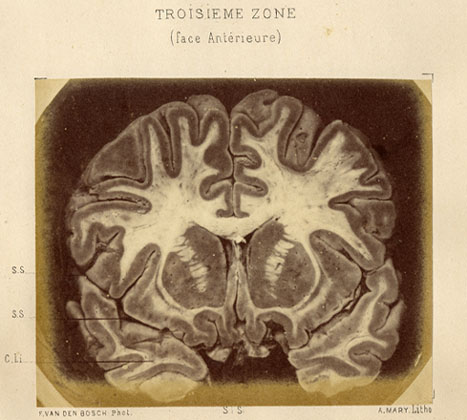
conservation des pièces normales et pathologiques par un procédé particulier.
Paris : aux Progrès Médical ; V. Adrien Delahaye, libraires-éditeurs ; 1878.
Description : [2]l., 40 p. [17 pl.] ; illus., 7 fig.s, plates (part fold.) ; 24 cm.
Photographs : 14 mounted albumens of brain sections.
Photographer : F. van den Bosch.
Subject : Anatomy – Brain ; Cerebral Localization.
Cited :
Dordick, Webb, Catalog 55: Antiquarian and Scarce Medical Books ;
(bookseller's catalog) #31, 2006.
Notes :
à Messieur le professeur Picot, au la part de l'auteur.
The 14 photographs show anterior and posterior faces of seven slices of the brain, beginning and ending with the corpus callosum. Bitot used a callote, a type of metal basket conformed to the shape of a brain and slotted so as to guide the sectioning knife along parallel planes. Callotes were fabricated for obtaining sagittal and transverse sections also, but only the coronal tranches were used in this study. Bitot was expositing for mathematical precision in the study of brain anatomy :
Les tranches ainsi obtenues ont la meme épaisseur, et la section passe toujours endes points symétriques sur les deux hémispheres. On conçoit sans peine combien ce résultat facilite l'étude des parties interstitielles de la masse cérébrale et la recherche d'une lésion morbide, d'un foyer hémorrhagique par exemple, dont il est ainsi facile de déterminer avec une précision mathématique les limites dans tous les sens.
To preserve the specimens for photographing and study, Bitot devised a metal chase similar in function to a shallow apple press, in which he would place two glass discs separated by a ring of vulcanized caoutchouc tubing. The brain section was sandwiched between the glass disks which were then compressed by a center screw of the chase. A liquid of equal parts alcohol and sugar syrup was siphoned in and then the pressure backed off so that a vacuum held the glass discs and specimen together. Bitot remarks that the glass encasement preserved the specimens indefinitely.

